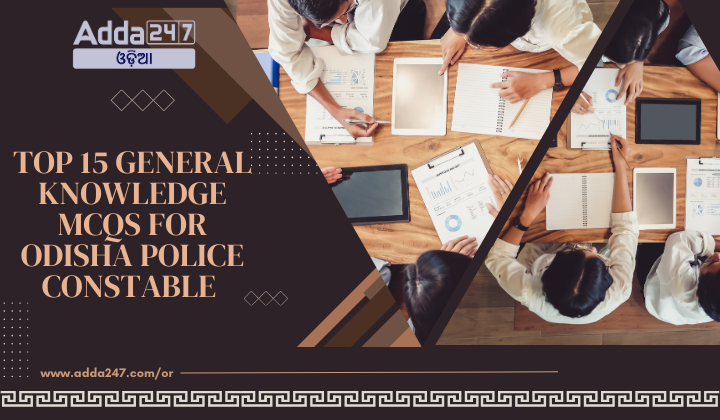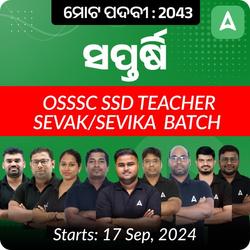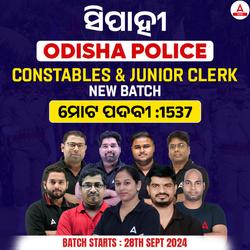Odisha Police Constable exams test aspirants on various subjects, including general knowledge, which plays a critical role in determining the candidate’s performance. Preparing for GK questions on topics such as Science & Technology, Polity, Awards, Odisha’s geography, and Current Affairs ensures a well-rounded understanding. This set of 15 general knowledge multiple-choice questions (MCQs) has been carefully curated to cover diverse topics such as the Constitution, Nobel Prizes, Census 2011, and key aspects of Odisha’s rivers, neighboring states, forests, and elections. By practicing these questions, aspirants can sharpen their knowledge to excel in the exam.
Top 15 General Knowledge MCQs For Odisha Police Constable
Q1. Which river of India is called Vridha Ganga?
(A) Krishna
(B) Godavari
(C) Kaveri
(D) Narmada
S1. Ans: (B) Godavari
Sol. The Godavari River is referred to as “Vridha Ganga” due to its large size and cultural significance, similar to that of the Ganga in North India.
Q2. Which latitude passes through the middle of India?
(A) Equator
(B) Arctic Circle
(C) Tropic of Capricorn
(D) Tropic of Cancer
S2. Ans: (D) Tropic of Cancer
Sol. The Tropic of Cancer, located at approximately 23.5°N latitude, passes through the middle of India and divides the country into two halves: the tropical south and the subtropical north.
Q3. Which foreign country is closest to Andaman Islands?
(A) Sri Lanka
(B) Indonesia
(C) Myanmar
(D) Pakistan
S3. Ans: (C) Myanmar
Sol. The Andaman Islands lie in the Bay of Bengal, and the closest foreign country to this archipelago is Myanmar, located to the north.
Q4. The state of Assam has:
(A) Five National Parks and eleven wildlife sanctuaries
(B) Three National Parks and nine wildlife sanctuaries
(C) Three National Parks and eight wildlife sanctuaries
(D) Two National Parks and eleven wildlife sanctuaries
S4. Ans:(A) Five National Parks and eleven wildlife sanctuaries
Sol. Assam is rich in biodiversity and has five National Parks (including Kaziranga, Manas, and Dibru-Saikhowa) and eleven wildlife sanctuaries, making it a significant conservation hub.
Q5. Kapildhara Falls is situated on which river?
(A) Tapi
(B) Sharavati
(C) Narmada
(D) Indravati
S5. Ans:(C) Narmada
Sol. Kapildhara Falls is located near Amarkantak in Madhya Pradesh and is formed by the Narmada River as it descends from the Maikal Hills.
Q6. Which of the following is a Trans-Himalayan river?
(A) Ganga
(B) Yamuna
(C) Indus
(D) Ravi
S6. Ans:(C) Indus
Sol. The Indus River originates in the Tibetan Plateau and flows across the Trans-Himalayan region into Pakistan. It is one of the longest rivers in the world.
Q7. India lies in the hemisphere:
(A) Northern and eastern
(B) Southern and eastern
(C) Northern and western
(D) Southern and western
S7. Ans:(A) Northern and eastern
Sol. Geographically, India is located in the Northern Hemisphere, and since it lies to the east of the Prime Meridian, it is also in the Eastern Hemisphere.
Q8. The staple food of the Vedic Aryan was
(A) Barley and rice
(B) Milk and its products
(C) Rice and pulses
(D) Vegetables and fruits
S8. Ans:(B) Milk and its products
Sol. The Vedic Aryans relied heavily on a pastoral economy, where cattle were of prime importance. Dairy products like milk, curd, and ghee formed a significant part of their diet, reflecting their agrarian-pastoral lifestyle. Other crops like barley were also consumed, but dairy was a staple.
Q9. The Saka Era was founded by
(A) Kadphises I
(B) Kanishka
(C) Alexander
(D) Menander
S9. Ans:(B) Kanishka
Sol. The Saka Era, also known as the Shaka Era, began in 78 AD during the reign of Kanishka, the great Kushan emperor. He is celebrated for initiating this era, which was widely used in the Indian subcontinent and in Southeast Asia.
Q10. Vasco-Da-Gama became the first European to set foot in India via the sea in____.
(A) 1488
(B) 1489
(C) 1498
(D) 1499
S10. Ans:(C) 1498
Sol. Vasco Da Gama, a Portuguese explorer, was the first European to reach India by sea when he landed in Calicut (now Kozhikode) on the southwestern coast of India in 1498. This event marked the beginning of European sea trade with India.
Q11. Mahatma Gandhi’s remark, ‘A post-dated cheque on a crumbling bank’ is regarding the proposal of ______
A) Simon Commission
B) Cripps Mission
C) Cabinet Mission
D) Wavel Plan
S11 Ans: (B) Cripps Mission
Sol. In 1942, the British government sent the Cripps Mission to secure Indian cooperation during World War II by promising future self-governance. Gandhi criticized the proposal, comparing it to a “post-dated cheque on a crumbling bank,” indicating that the promises were vague and unreliable.
Q12. Who composed the Gayatri Mantra?
(A) Vishvamitra
(B) Vasishtha
(C) Indra
(D) Parikshit
S12. Ans: (A) Vishvamitra
Sol. The Gayatri Mantra, one of the most revered mantras in Hinduism, is attributed to the sage Vishvamitra. It is found in the Rigveda and is a hymn dedicated to the Sun deity, invoking wisdom and spiritual awakening.
Q13. Upanishads are books on
(A) Religion
(B) Yoga
(C) Law
(D) Philosophy
S13. Ans: (D) Philosophy
Sol. The Upanishads are ancient Indian texts that form the philosophical foundation of Hinduism. They discuss metaphysical concepts such as the nature of reality, the self (Atman), and the ultimate reality (Brahman).
Q14. Patanjali is well known for the compilation of
(A) Yoga Sutra
(B) Panchatantra
(C) Brahma Sutra
(D) Ayurveda
S14. Ans: (A) Yoga Sutra
Sol. Patanjali, an ancient Indian scholar, is famous for compiling the Yoga Sutras, a foundational text of classical yoga philosophy. It outlines the practice of yoga as a means to achieve mental discipline and spiritual growth.
Q15. Who first imposed Jizya Tax in India?
(A) Allaudin Khilji
(B) Aurangzeb
(C) Mohammad Bin Qasim
(D) Qutb-ud-din Aibak
S1.5 Ans: (D) Qutb-ud-din Aibak
Sol. Qutb-ud-din Aibak, the founder of the Delhi Sultanate, is credited with imposing the Jizya tax on non-Muslims in India. Jizya was a tax levied on non-Muslims under Islamic rule as a form of protection tax. Although later rulers like Aurangzeb are more famously associated with it, Aibak was the first to implement it in India.










